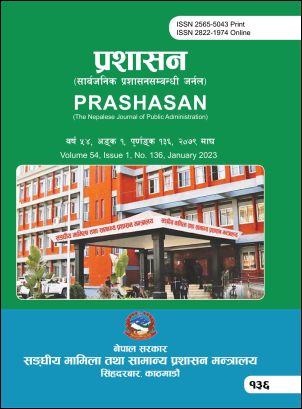Socio-Anthropological Understanding of Corruption and its Control
DOI:
https://doi.org/10.3126/prashasan.v54i1.53221Keywords:
Corruption, Social Norms, Dimension of Corruption, Anti-corruption MechanismsAbstract
Corruption is the misuse of power to obtain an unlawful advantage which depends on the power of actors, the profiteers, initiators, mechanisms and society where it takes place. Level, colour and activities are prime basis of classification of corruption. Before emergence of modern political thought religions have predominance over the corruptive act. Power and authority to misuse the position for involving improper actions and mistreatment by the agent to principal considered as an interactional, deterioration in morality as a normative and class based domination as a structural approaches of corruption. Socio-anthropological aspect elaborates corruption in terms of social norms such as democratic, psychological, micro analysis of gender as well as religious which vary with the structure of society. Klitgaard provided both conceptual and anti-corruption related formula to understand and control corruption. Different school and scholars provided different ideas regarding causes and dimensions of corruption. It is considered that the best socio-anthropological mechanisms to control corruption would be the legal, behavioural, gender, religious and collective approach with the primary focus against chronic corruption and clanism. However, the global nature of corruption, anti-corruption actions either institutional or legal provisions are established in each democratic country. As the value of CPI of In case of Nepal both types of mechanisms are established to control corruptive offences, but the value of CPI is low. That’s why the voice to control corruption differently, is raising now.
Downloads
Downloads
Published
How to Cite
Issue
Section
License
- The copyright of published materials of the journal remains with Ministry of Federal Affairs and General Administration.
- The published article cannot be reproduced or copied commercially by any person or institution but it can be used non-commercially for academic, research and training purpose providing proper citation is given.




